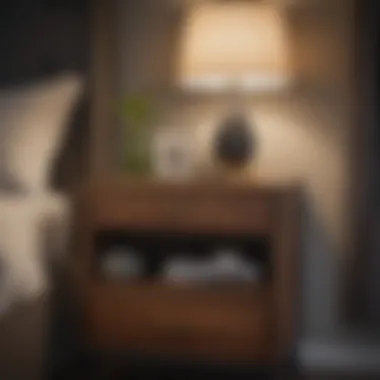Do Nightstands Need to Match Dressers? Exploring Design


Intro
The design choices that homeowners make greatly influence the atmosphere and functionality of a bedroom. Among these choices, the relationship between nightstands and dressers often raises questions. Do they need to match, or can they be different yet still work harmoniously? Understanding how these pieces influence a room's aesthetic is crucial for designers and homeowners alike.
In modern interior design, the notion of matching furniture has evolved dramatically. Many now embrace the idea that personal style and eclectic choices can create a more inviting and unique space. This article will examine various design inspirations, practical considerations, and tips to achieve a cohesive look in your bedroom, regardless of whether your nightstands and dressers match.
Design Inspirations
Trending Styles
In recent years, interior design trends have shifted toward a more personalized approach. Some popular styles include:
- Minimalism: Focusing on simplicity and clutter-free spaces, allowing a clear distinction between furniture pieces.
- Bohemian: Emphasizing a mix of colors, textures, and patterns, promoting a more eclectic vibe.
- Industrial: Featuring raw materials and rustic finishes, which may not require matching elements but instead highlight contrasts.
- Scandinavian: Characterized by clean lines and functional pieces, often allowing for variations in wood tones and styles.
These trends show the diversity in design preferences. Nightstands and dressers can share fundamental features without perfectly matching. For example, a distressed wooden dresser can pair well with a sleek metal nightstand, creating a conversation piece.
Color Palettes
Color selection plays a vital role in tying different pieces of furniture together. A carefully thought-out palette can bridge the gap between mismatched nightstands and dressers. Here are some effective approaches:
- Monochromatic Tones: Using varying shades of the same color can create visual harmony without complete matching. A light gray dresser can pair with a deeper gray nightstand.
- Contrasting Colors: Choosing colors that complement each other can also work well. A navy blue dresser paired with a white or gold nightstand creates a striking look.
- Natural Wood Finishes: Combining different wood tones can add depth to a room. It is essential to select woods that have similar undertones for a cohesive effect.
"Matching furniture is no longer the only way to design a cohesive bedroom. Different styles and colors can create a unique and personalized space."
By focusing on these inspirations, homeowners can navigate the decision of matching nightstands and dressers in a way that showcases their preferences while maintaining a coherent design aesthetic. The next section will explore practical considerations in choosing the right nightstands.
Preamble to Bedroom Design
The bedroom is more than a mere sleeping space. It is a personal sanctuary, where design choices reflect individual personality and set the mood for relaxation. Understanding the fundamentals of bedroom design is essential to create an inviting atmosphere. This article addresses one of the key questions in bedroom aesthetics: whether nightstands need to match dressers.
A cohesive design can significantly enhance the overall feel and functionality of a bedroom. When elements like nightstands and dressers are intentionally paired or thoughtfully contrasted, it helps in developing a harmonious space. Consideration of placement, color, and style are crucial elements to ponder.
Balancing function and beauty is key. Nightstands often serve practical purposes alongside aesthetics. They provide essential storage and surface area for personal items. Dressers, on the other hand, generally offer more substantial storage solutions, influencing the room's overall organization. Their interplay in design can either enhance or detract from the bedroom's harmony.
Ultimately, the design should reflect the homeowner's lifestyle and preferences. Personalization builds a connection to the space. It becomes a canvas of expression. Thus, understanding the dynamics between different furniture pieces enhances not just the appearance but also the experience of the bedroom. The subsequent sections will explore specifics about matching nightstands and dressers, providing a detailed analysis of the important design principles involved.
Historical Context of Bedroom Furnishings
Understanding the historical context of bedroom furnishings provides a foundation for contemporary design choices. The evolution of interior decor reflects societal shifts, economic changes, and cultural influences. This context informs current preferences, particularly regarding the relationship between nightstands and dressers.
Over centuries, bedroom furniture adapted to the needs and aesthetics of its time. In the Medieval period, for instance, practicality outweighed style. Furniture was often bulky, designed for durability rather than visual appeal. Fast forward to the Renaissance, where ornate designs symbolized wealth. This era introduced more refined shapes, allowing furniture to contribute decoratively to the chamber.
As we entered the 18th and 19th centuries, the Industrial Revolution brought about mass production. This evolution democratized style, making fashionable furnishings accessible to a broader audience. Styles such as Victorian or Federal featured architectural elements, often encouraging the integration of nightstands and dressers to match, showcasing unity in vision.
In contemporary design, personal expression is paramount. Choices regarding bedroom furniture have shifted toward individualistic styles. Homeowners now focus on how pieces like nightstands relate not only to dressers but to the overall room aesthetic. The need for harmony does not always require matching, but understanding historical norms helps clarify contemporary preferences.
The Evolution of Bedroom Decor
The evolution of bedroom decor highlights significant transitions influenced by cultural and social movements. For example, during the Arts and Crafts movement in the late 19th century, handcrafted designs gained popularity. This focus on craftsmanship encouraged personal connections to the furnishings, steering away from the concept of mandatory matching.
Modern minimalism also emerged as a reaction to previous opulence. Designs are clean and functional, emphasizing simplicity. In such styles, nightstands may diverge from dressers as the purpose shifts to creating space and tranquility in the bedroom.
Exploring how these trends shape expectations surrounding nightstands and dressers reveals much about current design practices. Instead of rigid matching rules, a blend of styles may be seen, allowing homeowners to express unique tastes within their private spaces.
Understanding the evolution of bedroom furnishings helps designers and homeowners alike create cohesive and personalized spaces in modern interior design.
Defining Nightstands and Dressers
When considering bedroom design, it helps to define what nightstands and dressers are. Each piece of furniture serves unique functions that contribute to the overall aesthetic and practicality of a bedroom. Understanding these roles is essential, not only for making informed choices but also for crafting a unified visual appeal that resonates with personal tastes.
Functionality of Nightstands
Nightstands are often placed beside the bed. They offer essential functions that enhance both convenience and comfort. Typically, a nightstand holds items that one may need within reach while in bed. These may include lamps for light, books for reading, or a glass of water to quench thirst. The surface area provides a place to set things down.
In terms of storage, nightstands usually come with drawers or shelves. This enables storage of personal items such as medications or chargers, keeping the space tidy. This functionality makes a nightstand much more than an aesthetic piece; it's a practical necessity in bedroom design.
The Role of Dressers
Dressers serve another critical role in bedroom organization. They are primarily for clothing storage. Unlike nightstands, dressers typically offer larger drawers that accommodate bulkier items like sweaters or jeans. This helps maintain order in a often chaotic space, allowing easy access to clothes without cluttering the bedroom.
Dressers also contribute to the aesthetic appeal of the room. They can act as a focal point, especially when decorated with mirrors or accessories. Additionally, they often remain a consistent design element throughout the room, offering a stylistic equilibrium with other furniture, such as nightstands.
In summary, defining the roles of nightstands and dressers is necessary for understanding how they complement each other in bedroom design. While functionality is key, the unique design features of each play an equally important role in creating a cohesive look.
The relationship between nightstands and dressers plays a crucial role in the overall aesthetic of a bedroom. The question of whether or not these two essential pieces of furniture need to match reflects deeper insights into personal style, design philosophy, and practical functionality. Designing a cohesive look can affect the way we perceive our space and interact with it.


Matching nightstands and dressers can create a sense of unity and harmony within the bedroom. This can be particularly important in smaller spaces where visual balance is needed to evoke a calming atmosphere. Moreover, the right pairing can enhance the overall style, whether it’s traditional, contemporary, or eclectic. However, the need for a perfect match can be more flexible depending on the homeowner's individual preferences and the characteristics of the room.
Consideration factors like color, style, and material are essential. If these elements complement each other, they can still create an aesthetically pleasing environment without being identical. Conversely, mismatched furniture can impart a sense of personal expression and creativity. Achieving the right balance allows for a unique portrayal of one’s style.
Design Principles Behind Matching
Understanding design principles is vital for choosing nightstands that pair well with dressers. Balance is one significant principle in design. When nightstands match dressers, they establish a symmetrical appearance, which can lead to a visually appealing space. Such balance draws the eye smoothly across the furniture pieces, contributing to an orderly environment.
Contrast, on the other hand, is equally important. Slightly differing styles or colors can create a dynamic look while maintaining harmony. For example, combining a dark wood dresser with a lighter wood nightstand can add depth and interest without losing coherence. This approach emphasizes individual pieces while still maintaining a connection between them.
Scale and Proportion also play vital roles. When selecting nightstands and dressers, it is crucial to consider their size relative to each other and the overall room. A towering dresser with petite nightstands may disrupt visual balance. Conversely, every piece should feel like part of a larger design story. Aligning scale can enhance the overall harmony of the bedroom.
Breaking Traditional Norms
Traditionally, designers have recommended matching nightstands and dressers for a more polished and coordinated look. However, in recent years, there has been a noticeable shift in mindset. Breaking from tradition can lead to innovative and personal spaces. Embracing diversity in design allows for a broader expression of self.
Homeowners are more willing to mix styles, colors, and finishes, creating an unorthodox yet coherent bedroom environment. For instance, a rustic nightstand can complement a sleek, modern dresser, showcasing a dichotomy that reflects personal taste and creativity.
Flexibility in design invites personality into the space, inviting homeowners to curate their unique ambience.
Additionally, embracing an eclectic design approach may also underscore the homeowner's life experiences and travels. Artifacts from different cultures or vintage finds can add authenticity and narrative to the space.
The Impact of Style on Choice
When designing a bedroom, the choice of furniture style plays a crucial role. The impact of style on your selection process often shapes not just the aesthetic appeal but also the overall functionality. It impacts how the pieces relate to each other and how they contribute to your personal comfort.
Key considerations include:
- The essence of the chosen style
- How different styles harmonize or clash
- The scope for personal expression through design
Selecting nightstands to complement your dresser requires an understanding of the design principles involved. Each style brings its own set of characteristics that inform how each piece will work together. As a result, this creates a cohesive visual narrative or, quite possibly, a disjointed one.
Modern Minimalism
Modern minimalism embraces simplicity and functionality. This style usually features clean lines, neutral colors, and a lack of excessive ornamentation. When choosing nightstands under this philosophy, focus on pieces that complement the dresser in a subtle manner. For instance, a sleek white nightstand can be an excellent counterpart to a similarly styled white dresser.
Benefits of modern minimalist nightstands include:
- Efficient use of space
- An uncluttered appearance
- Ease of upkeep and maintenance
Additionally, utilizing materials such as metal and glass can further enhance the modern aesthetic. Stick to geometric shapes and avoid intricate patterns to maintain that minimalist vibe. This style allows for personalization while maintaining a coherent look, making it perfect for those who prefer a calm bedroom environment.
Rustic and Vintage Styles
For individuals drawn to rustic and vintage aesthetics, the integration of nightstands and dressers can result in a warm and inviting atmosphere. This styling often employs natural materials like wood, showcasing grain texture and finishes that speak to a bygone era. The beauty lies in imperfection, where rustic charm shines through distressed finishes and unique craftsmanship.
When selecting nightstands to match a rustic dresser, consider showing:
- Wood finishes that mirror or complement the dresser.
- Vintage-inspired hardware that ties pieces together.
Mixing these elements provides not just functionality but also a narrative of history and character. An old wooden nightstand with visible knots or a vintage nightstand can add depth to the room, promoting a sense of curated personal history. The cohesion found in this pairing speaks to a narrative that resonates well with homeowners who value tradition and craftsmanship.
Complementary Designs
When it comes to bedroom design, complementary designs play a vital role in achieving visual harmony. The synergy between nightstands and dressers can significantly affect the overall aesthetic of the room. Striking a balance between these two furniture pieces contributes to a unified look while allowing room for personal expression.
Focusing on complementary designs can help create an environment that feels cohesive and tailored. It allows homeowners to leverage different elements such as colors, materials, and style without sacrificing individuality. Understanding these relationships between nightstands and dressers is essential for anyone seeking a refined and sophisticated bedroom ambiance.
Color Coordination
Color coordination is a fundamental aspect in establishing a complementary relationship between nightstands and dressers. Color can dictate the mood of a room, and the right palette can create a sense of calmness or vibrancy. Using colors that align well with each other fosters a cohesive look.
Homeowners often choose to either match these pieces or select colors that complement one another. Here are some considerations:
- Accent Colors: Introducing an accent color can bridge the gap between different pieces. For example, a white dresser paired with a navy blue nightstand can provide contrast while still keeping the overall aesthetic pleasing.
- Color Shades: Using different shades of the same color can create depth in the room. A light gray dresser with a charcoal nightstand, for instance, maintains a sophisticated monochromatic look while adding interest.
- Contrasting Colors: For those who prefer bold statements, using contrasting colors can make each piece stand out. Just ensure the contrast doesn’t clash, as it can disrupt the flow of the room.
Ultimately, considering color coordination ensures that nightstands and dressers complement rather than compete.
Material and Texture Matching
Material and texture are just as crucial as color in achieving balance in bedroom design. The choice of materials can reflect personal style and influence the room's warmth and comfort. Selecting materials that work well together can enhance the overall aesthetic.
Some key points to consider include:
- Wood Types: If a dresser is made of oak, opting for a nightstand in a similar wood type can create visual cohesion. However, contrasting woods can also work if textures align well.
- Finishes: A glossy finish on a contemporary nightstand can work well with a matte-finished dresser, provided each piece reflects the room's overall theme.
- Textures: Mixing textures can add dimension. A smooth surface on a nightstand contrasts beautifully with a textured dresser. Soft fabrics, such as upholstered nightstands, can add warmth against a wooden or metallic dresser.
To ensure all materials and textures harmonize, consider the overall theme of the room. Mixing elements thoughtfully encourages balance while still allowing for individuality in the style of the nightstand and dresser combination.


How to Choose the Right Nightstand
Choosing the appropriate nightstand involves several practical consideration that directly influence bedroom functionality and aesthetics. Nightstands play a vital role in completing the look of a bedroom while offering essential storage and surface space. When selecting a nightstand, one must think about how it will fit within the overall design scheme and serve the specific needs of the user.
Assessing Space and Size
When deciding on a nightstand, measuring the space available is crucial. Consider both the dimensions of the room and the furniture already in place. For a well-proportioned design, a nightstand should not overwhelm the bed or make the room feel cramped. Here are some factors to consider:
- Height: The height of the nightstand should align with the mattress level for easy access to items.
- Width: A too-wide nightstand can obstruct pathways, while a too-narrow one might not provide adequate surface space.
- Depth: Ensure that the depth does not interfere with any doors or drawers in the vicinity.
A smaller nightstand may work in tighter spaces, but it’s good to check if it offers enough storage, such as shelves or drawers.
Functionality Needs
Nightstands serve various functions, and it is important to think about how you intend to use yours. Different users may prioritize different features based on lifestyle preferences:
- Storage Options: If you have many bedside items, consider a nightstand with drawers or an open shelf for easy access.
- Surface Area: A larger surface can accommodate lamps, clocks, books, or even drinks.
- Electrical Needs: With the prevalence of devices, having a nightstand with built-in charging ports can be beneficial.
Choosing a nightstand that meets your functionality needs while still fitting well in your bedroom design can significantly enhance the space.
Ultimately, the right nightstand should complement your room's aesthetic while fulfilling practical purposes.
Variety of Styles for Nightstands
The variety of styles for nightstands plays a crucial role in bedroom design. Each style brings its unique character and functionality to the space. Understanding the different options is necessary for homeowners and design enthusiasts to create an atmosphere that resonates with personal taste and functionality.
Choosing nightstands is not just about matching them with dressers. It's about finding elements that enhance the overall bedroom experience while reflecting individual style. The options range from traditional to contemporary, and even eclectic, allowing for flexibility in design choices. This diversity also provides opportunities for incorporating various materials, colors, and forms that can contribute to an inviting ambiance.
Traditional Nightstands
Traditional nightstands often embody a classic design. They are characterized by wood construction, rich finishes, and intricate details, such as carvings or drawer pulls. These pieces are usually symmetrical and feature a sturdy structure, presenting an elegant and timeless look.
- Materials: Most traditional nightstands are made from solid wood like oak or mahogany, which offer durability and a sense of warmth.
- Features: They often come with drawers and shelves that help keep nighttime essentials organized. The design allows for easy access to items like books or lamps.
- Color Choices: The color palette for traditional nightstands typically includes deep stains or painted finishes that complement classic bedroom themes.
This style is suitable for homeowners who appreciate a more established and classic feel in their bedrooms. It can enhance the beauty of more traditional dressers with matching aesthetics.
Contemporary Nightstands
Contemporary nightstands focus more on minimalism and functionality. They commonly feature clean lines, sleek designs, and a variety of materials, including metal and glass. This style reflects modern trends and often caters to a more urban audience.
- Design Elements: These nightstands tend to be simple yet striking, often utilizing innovative designs that maximize space without being cumbersome.
- Color and Finish: Standard colors range from whites and blacks to bold hues, making them versatile additions to any modern bedroom.
- Variable Structures: Many contemporary designs include multifunctional features, like built-in charging ports or hidden compartments, adapting to the tech-savvy needs of today’s homeowners.
For those who lean towards modern decor, these nightstands provide flexibility and practicality. They can create contrast when paired with more traditional dressers.
Eclectic Options
Eclectic nightstands are ideal for those looking to express their creativity and unique style. This variety allows for mixing and matching, resulting in diverse pieces that can range from vintage to industrial or bohemian styles.
- Diverse Materials: An eclectic nightstand can be made from a range of materials like reclaimed wood, metal, and even plastic. This mix leads to uniqueness and character.
- Varied Designs: These nightstands may have ornate decorations, unconventional shapes, or colorful finishes that stand out and draw attention. Incorporating one can become a focal point of the room.
- Personal Touch: Homeowners can personalize their bedroom by choosing pieces that resonate with their style. This option allows for continual change, accommodating evolving tastes over time.
In summary, the variety of styles for nightstands provides options that cater to different design preferences and practical needs. Understanding these can help homeowners make informed choices that contribute to a cohesive and functional bedroom design.
Practical Considerations
In bedroom design, practical considerations play an essential role in selecting nightstands and dressers. These elements directly affect not just the aesthetics but also the functionality and longevity of the furniture in your space. Before making decisions, it is worthwhile to evaluate key factors like budget, durability, and maintenance to create a harmonious environment that meets your needs.
Budget Constraints
When it comes to furnishing a bedroom, budget constraints are a primary concern for many homeowners. Establishing a budget before shopping helps in narrowing options effectively. Nightstands can range from inexpensive to high-end designer pieces. By deciding on a price range, one can avoid overspending and make better-informed choices.
- Identify essential features: Before you look for nightstands, think about what functions you need. Do you prefer drawers for storage or open shelves for decor? Understanding this will allow you to find more cost-effective options.
- Research: Explore various retailers for sales or discounts. Websites like reddit.com can provide insights into affordable yet stylish options.
Spending on complementary pieces, such as lamps or decor, can influence the overall budget. It may be better to pick simpler nightstands and spend on accessories that resonate with your personal style.
Durability and Maintenance
Durability is another critical factor. Quality materials determine how well furniture can withstand daily wear and tear. When selecting a nightstand, consider how it aligns with your lifestyle and the care it may require. You should prioritize materials that offer both durability and ease of maintenance.
- Material choice matters: Wood, metal, and composite materials all have different durability levels. Solid wood, for example, often lasts longer but may require certain maintenance practices. In contrast, painted or laminate surfaces are easier to clean but may not be as long-lasting.
- Maintenance practices: Depending on the selected materials, routine cleaning can vary. Some finishes may need special cleaning agents to maintain their appearance, while others only require a damp cloth. Factor these maintenance needs into your decision-making process.
In summary, practical considerations significantly shape the selection of nightstands and dressers. Attention to budget and durability ensures that your choices are not only aesthetically pleasing but also functional and sustainable.
Integrating Different Styles
Integrating different styles in bedroom design is an essential consideration for homeowners and interior design enthusiasts alike. This concept extends beyond mere aesthetics; it embodies a philosophy of personalization and expression within the intimate space of the bedroom. When nightstands and dressers do not match, the design choices can reveal the inhabitant's character.
Combining styles introduces variety and depth into the overall look. Additionally, it allows for the blending of traditional elements with contemporary designs, creating a unique interplay of textures, colors, and shapes. Most importantly, this integration can accommodate changes in personal taste over time without the need for complete overhauls in the room's design.


However, there are some important considerations to keep in mind when integrating different styles. One must think about proportions and balance, as mismatched pieces can lead to a cluttered effect, or make the room feel disjointed. Careful curation of items contributes to a cohesive visual dialogue across the space.
"The key to successful integration is to establish a common thread, be it color, material, or form. This can elevate the overall experience of the space."
Finding a synergy between styles allows homeowners to create a narrative in their design choices. It is about choosing elements that resonate together rather than adhere strictly to predefined match rules.
Mixing Genres
Mixing genres involves the juxtaposition of varying design styles to cultivate a distinctive look. For instance, combining mid-century modern furniture with rustic touches can give an eclectic yet harmonious feel. When mixing genres, focus on a few guiding principles to achieve balance. These can include:
- Color Palette: Select colors that can pertain to both designs. Neutral tones often act as a bridge between bold hues and more muted ones.
- Materials: Use a combination of different materials, such as wood, metal, or glass. However, ensure that they blend well visually.
- Shape: Pair pieces with complementary shapes. For example, round nightstands can work well with angular dressers as long as their stylistic essence aligns.
Being intentional with each choice can lead to a successful fusion of genres that enhances the bedroom’s personality.
Creating Harmony with Accessories
Accessories play a pivotal role in unifying different styles within a bedroom setting. They serve as transitional elements, linking the nightstand and dresser while tying the room together. Key accessories that can foster this harmony include:
- Artwork: Hang art pieces on the wall that resonate with both the nightstand and dresser styles.
- Textiles: Consider using textiles such as throws and cushions to invoke warmth. Choose fabrics that appear in various sections of the room.
- Lighting: Lamps on the nightstand can echo finishes or styles of the dresser, creating a unified look.
When integrating accessories, less can often be more. Select pieces that elevate the overall decor without overwhelming the senses. This balance ensures that the room remains functional and inviting.
Practical Examples
In the context of bedroom design, practical examples serve as invaluable references. They allow homeowners and design enthusiasts to visualize various pairings of nightstands and dressers. Practical examples highlight the benefits and considerations of different styles and combinations, offering a roadmap for personal preferences. The goal is to inspire creativity and functional arrangements.
Case Studies of Successful Pairings
Exploring real-world case studies can be insightful. For instance, in a contemporary setting, a sleek white nightstand can perfectly complement a dark wood dresser. This contrast not only enhances visual appeal but also emphasizes individual elements. Similarly, a rustic nightstand paired with a vintage dresser creates warmth and a sense of nostalgia.
Consider a bedroom where a modern nightstand from West Elm was matched with an antique dresser found at a flea market. The juxtaposition draws attention and creates a unique statement, demonstrating the effectiveness of blending styles. Each case showcases how functional and aesthetic choices can significantly impact the overall bedroom experience.
Lessons from Design Experts
Design experts often stress the importance of personal expression in bedroom design. They encourage experimenting with various styles and colors. A lesson from well-known interior designer Marie Flanigan emphasizes that mixing materials, such as metal and wood, can create a balanced look and feel.
Furthermore, using accessories can help tie different pieces together. For example, selecting lamps, decorative trays, or artwork that echo colors from both the nightstand and dresser can unify the spaces. In addition, considering lighting can change the perception of color and texture, offering even more depth to the design.
Ultimately, practical examples not only guide individuals in choosing the right nightstands but also empower them to make informed decisions that cater to their personal style.
User Preferences and Personalization
In bedroom design, personalization plays a crucial role. Each individual's preferences dictate how their space reflects their personality and lifestyle. This section explores user preferences and personalization in terms of matching nightstands and dressers. The relationship between these elements goes beyond mere aesthetics. It intertwines with how homeowners feel in their space. Personal expression through design choices can lead to greater comfort and contentment.
Understanding one’s personal style is essential. It encompasses choices regarding colors, materials, and overall themes. Some may prefer a cohesive look, where nightstands and dressers match seamlessly. Others may lean toward a more eclectic approach, combining distinct styles to create a unique bedroom statement. Exploring personal style enables homeowners to make informed decisions about their furnishings.
Benefits of Personalization:
- Enhanced Comfort: A space designed to suit personal taste can significantly improve daily life.
- Self-Expression: Individuals can showcase their personality through choices in decor and arrangement.
- Aesthetic Cohesion: Maintaining a balance or intentional mismatch can create a visually appealing environment.
When discussing nightstands and dressers, it's vital to consider how they interact with individual preferences. A perfectly matched set may initially seem appealing but could hinder the expression of personal style. Thus, a diverse approach often leads to stunning outcomes.
Understanding Personal Style
Understanding personal style is fundamental in the design process. It includes self-awareness about what one truly enjoys. Some individuals may gravitate towards minimalist designs, valuing simplicity and functionality. Others might appreciate ornate pieces filled with character and history.
Several factors contribute to developing personal style:
- Lifestyle Needs: Activities such as reading or having drinks before bed affect nightstand choice. For instance, a larger surface may be needed if one enjoys books and gadgets.
- Emotional Connections: Items inherited or collected can lead to an individual’s distinctive style.
- Color Preferences: Preferences in color can significantly influence choices. A homeowner may favor muted tones, while another might prefer vibrant shades.
Recognizing and solidifying one's personal style is key to blending nightstands and dressers effectively. A thoughtfully curated space reflects individuality, invites comfort, and supports daily routines.
Adapting Trends to Individual Tastes
Trends in interior design often shift rapidly. Yet, adapting these trends to fit personal tastes is critical for homeowners. Following design fads without regard for personal preference can create a disjointed space. Therefore, understanding how to adapt trends while remaining authentic is valuable.
Key considerations in adapting trends include:
- Selectivity: Only incorporate elements of a trend that resonate personally. For example, if a particular color is trending but does not align with the preferred palette, it is sensible to let it go.
- Combination: Mix trending elements with existing decor. This creates a dialogue between old and new, enhancing the overall aesthetic.
- Functionality: Ensure that any trendy designs serve practical needs. Fashionable nightstands may come with less storage, which might not be suitable for everyone.
Ultimately, personal taste should steer the integration of trends into bedroom decor. This way, homeowners can achieve a pleasing balance that feels authentic and enjoyable. The focus should always remain on creating a space that feels uniquely theirs.
Finale
In summary, the question of whether nightstands have to match dressers encompasses much more than simple aesthetics. It urges us to examine the principles of design and personal expression within our spaces. Matching nightstands and dressers can create a sense of uniformity, but it is not a necessity for a well-designed bedroom.
One key aspect discussed in this article is the significance of personal style. Homeowners and design enthusiasts are encouraged to infuse their bedroom with elements that resonate with their tastes. This personal touch fosters a unique and comfortable environment where they spend considerable time.
Benefits of a Cohesive Design
When nightstands and dressers are coordinated, they can contribute to a harmonious visual flow. This cohesion can enhance deeper feelings of peace and stability for anyone entering the space. Conversely, intentionally selected mismatched pieces can also express individuality and creativity, challenging conventional norms within bedroom design.
Considerations in Practice
Practical considerations also emerge from our discussion, such as space assessment, functionality needs, and budget constraints. Not only do these elements play a role in the selection of nightstands, but they can also influence how these pieces complement or contrast with the dresser. For instance, a multi-functional nightstand can serve more than just a surface for a lamp, while a decorative element may enhance the overall look even if it is not an exact match.
Ultimately, the decision about nightstands and dressers should reflect both personal taste and lifestyle requirements. Achieving a balance between style and practicality is essential, contributing to the overall satisfaction of those using the space.







